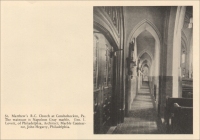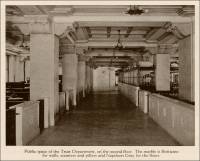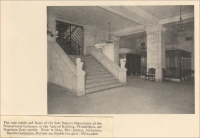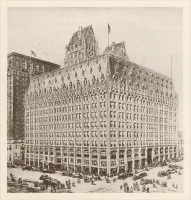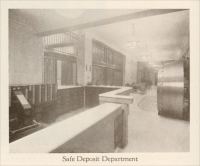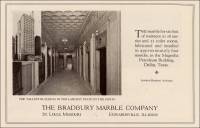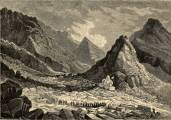


Structures and Monuments in Which Missouri Stone was Used
- Finished Products from Missouri Stone in Pennsylvania
-
Coshocton, Pennsylvania – the Coshocton National Bank Interior (from Napoleon Gray, An Adaptable Marble, Phenix Marble Company, Kansas City, Missouri, Producers, and Tompkins-Kiel Marble Company, New York City, New York, Distributors, 1926, pp. 43)
-
Conshohocken, Pennsylvania – the St. Mathew’s Roman Catholic Church – the Wainscot (from Napoleon Gray, An Adaptable Marble, Phenix Marble Company, Kansas City, Missouri, Producers, and Tompkins-Kiel Marble Company, New York City, New York, Distributors, 1926, pp. 34)
-
Lansdowne, Pennsylvania – the St. Philomena Roman Catholic Church (from Napoleon Gray, An Adaptable Marble, Phenix Marble Company, Kansas City, Missouri, Producers, and Tompkins-Kiel Marble Company, New York City, New York, Distributors, 1926, pp. 27)
- Philadelphia, Pennsylvania – the Girard College Group - the High School & the Recreation Building (from the article entitled, The Girard College Group: “Redeeming what was lovely in the ancient pile from the decay of the centuries,” in Throvgh The Ages Magazine, March 1926, Vol. 3, No. 11, pp. 18-24.)
“The next important addition to Girard College was the erection of a new High School building, to provide accommodation for about 800 boys. It was begun in 1913 and occupied in 1916, and its architecture reverted once again to the Greek style, its spirit and character being similar to that of the original group...The halls and stairways are finished in Napoleon Gray marble. John T. H. Windrim who designed the buildings erected during the middle period of the college’s history, was the architect.”
“The Recreation Building, also by John T. Windrim, was finished in 1924...The halls and corridors of the interior, as in the High School, are finished in Napoleon Gray from Missouri.”
- Philadelphia, Pennsylvania - the Insurance Company of North America Building - the Corridor (from Stone Magazine, November 1926, Vol. XLVII, No. 11, pp. 669)
- Philadelphia, Pennsylvania - the Master Street High School (from Missouri Marble, by Norman S. Hinchey, Report of Investigations No. 3, Missouri Geological Survey and Water Resources, Rolla, Missouri, 1946. Used with permission of the Missouri Department of Natural Resources.)
Eldorado or Ste. Genevieve Istrian Marble quarried from the Inkley Marble Quarries Company quarry located southwest of Ste. Genevieve, Missouri, was used in the construction of the Master Street High School.
- Philadelphia, Pennsylvania - the Naval Hospital (from Missouri Marble,
by Norman S. Hinchey, Report of Investigations No. 3, Missouri Geological
Survey and Water Resources, Rolla, Missouri, 1946. Used with permission
of the Missouri Department of Natural Resources.)
Ste. Genevieve Golden Vein Marble, quarried in Ste. Genevieve County, Missouri, was used in the construction of the Naval Hospital.
- Philadelphia, Pennsylvania - the Packard Building - Main Banking Room Floor & Treads & Risers of Vestibule Level Main Staircase & Trust Department Floors (from article entitled, “The Packard Building: A Quaker City Structure that Contains a Banking Room Modelled (sic) after a Roman Basilica,” in Throvgh The Ages Magazine, December 1925, Vol. 3, No. 8, pp. 12-20)
The Vestibule: “From any point in this vestibule, there is presented a profusion of gleaming marble surface interrupted at intervals by rich carving and delicate moulding...The treads and risers of the main stair are of Napoleon Gray marble, as are also the floors of both vestibule and bank.”
Details of carved newel at Vestibule level of main stair. All of this stairway is of Botticino marble, except the treads and risers, which are of Napoleon Gray. (pp. 15) 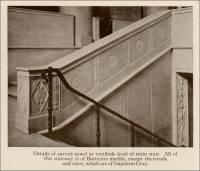
The Main Banking Room: “The main banking room is a spacious chamber that is reminiscent of the roman basilica...The marble wall ashlar is 30 feet high; the floor is of Napoleon Gray marble.”
General view of Main Banking Room, looking toward the grand stairway from the Chestnut Street entrance. (pp. 16) 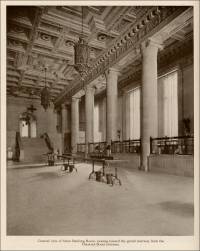
The Safe Deposit Department: “In the Safe Deposit department the floors are of Gray Napoleon marble with side walls and columns of limestone....”
-
Philadelphia, Pennsylvania – the Packard Building – the Pennsylvania Company Main Banking Room – the Floor & Stair Treads (from Napoleon Gray, An Adaptable Marble, Phenix Marble Company, Kansas City, Missouri, Producers, and Tompkins-Kiel Marble Company, New York City, New York, Distributors, 1926, pp. 43 and 46)
- Philadelphia, Pennsylvania - the Packard Building - the Pennsylvania Company Packard Building - Main Banking Room (Salomone-O'Brien Marble Co., Knoxville, Tennessee, advertisement from Throvgh The Ages Magazine, April 1926, Vol. 3, No. 12, pp. 50.)
Main Banking Room of the Pennsylvania Company, Packard Building, Philadelphia. Ritter & Shay, Architects.
Main Entrance to Banking Room.
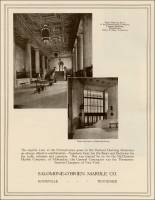
Salomone-O’Brien Marble Co., Knoxville, Tennessee
In marble work in the Pennsylvania space in the Packard Building illustrates an always effective combination - Napoleon Gray for the floors and Botticino for the walls, columns and counters. This was erected by us for the McClymont Marble Company, of Milwaukee; the General Contractor was the Thompson-Starrett Company of New York.
-
Philadelphia, Pennsylvania – the Tenth National Bank of Philadelphia – the Floors & Counters (from Napoleon Gray, An Adaptable Marble, Phenix Marble Company, Kansas City, Missouri, Producers, and Tompkins-Kiel Marble Company, New York City, New York, Distributors, 1926, pp. 44)
- Philadelphia, Pennsylvania - the U. S. Post Office Building (from Missouri Marble,
by Norman S. Hinchey, Report of Investigations No. 3, Missouri Geological
Survey and Water Resources, Rolla, Missouri, 1946. Used with permission
of the Missouri Department of Natural Resources.)
Ozark Tavernelle Marble (a limestone) quarried at Carthage, Missouri, was used in the construction of the interior of the U. S. Post Office building.
- Pittsburgh, Pennsylvania - the Jones Building (from “New Missouri Marble Mill,”in Stone Magazine, November 1925, Vol. XLVI, No. 11, pp. 674-676)
Colonial Grey Marble quarried by F. W. Steadley & Co., Inc., of Carthage, Missouri, was used in the construction of the Jones building prior to 1926.
- Pittsburgh, Pennsylvania – the Union Trust Bank Building – Some of the Toilet Rooms (from the article entitled, “The Union Trust Company of Pittsburgh,” in Throvgh The Ages Magazine, December 1925, Vol. 3, No. 8, pp. 34-38.)
“The marble work in the Union Trust Bank Building is both well planned and excellently carried out. The materials used are mostly Tavernelle, with Tennessee marble floors, though several of the toilet rooms are executed in white Italian and others in Carthage marble.”
-
Pittsburg, Pennsylvania – the Union Trust Company Building – some of the Toilet Rooms (from “The Union Trust Company of Pittsburg: Andrew W. Mellon, Secretary of the United States Treasury, was the first president of the institution” (the Union Arcade building), Through the Ages, January 1926, Vol. 3, No. 9, pp. frontispiece, 34-38.
According to this article, the exterior of the Union Arcade building is an example of Gothic architecture. “Massive grilled bronze doorways lead from Fifth Avenue and the arcade to the main banking room…At the center of this splendid hall stand two rows of marble columns, sixteen columns in all flanking the main vista….Sixteen columns in marble rising to the ceiling are of Tavernelle, and the same material being used on the walls of the cella….”
“The marble work in the Union Trust Bank Building is both well planned and excellent carried out. The materials used are mostly Tavernelle, with Tennessee marble floors, though several of the toilet rooms are executed in white Italian and others in Carthage marble.”
-
- Pittsburg, Pennsylvania – the Vandergriff Building (from The Quarrying Industry of Missouri, by Ernest Robertson Buckley and H. A. Buehler, 1904, page 74)
Deep red colored granite quarried in the Graniteville, Missouri, quarries was used with wholly or in part in the construction of the Vandergriff building.
- Pittsburgh, Pennsylvania - Yale University - the
Harkness Memorial (from “New Missouri Marble Mill,” in Stone Magazine,
November 1925, Vol. XLVI, No. 11, pp. 674-676)
Colonial Grey Marble quarried by F. W. Steadley & Co., Inc., of Carthage, Missouri, was used in the construction of the Harkness Memorial at Yale University prior to 1926.
- Washington County, Pennsylvania - the Madonna of the Trail Statue in Washington County, Pennsylvania, dedicated on December 8, 1928 (photographs) The following quotation is from Wikipedia, the free encyclopedia.
The following quotation is from Wikipedia, the free encyclopedia.
“Madonna of the Trail is a series of monuments dedicated to the spirit of pioneer women in the United States. The monuments were commissioned by the National Society of Daughters of the American Revolution (NSDAR). They were placed along the National Old Trails Highway and extended from Bethesda, Maryland, to Upland, California, in each of the 12 states the road passed through.
“Created by sculptor August Leimbach and funded by contributions, the Madonna of the Trail monuments were intended to provide a symbol of the courage and faith of the women whose strength and love aided so greatly in conquering the wilderness and establishing permanent homes.
“Dedicated in 1928 and 1929, with each of the 12 located in a different state, they became a source of local pride. Through the continuing efforts of local and national groups, all are currently in good condition and on display....”
“The figure stands 10 feet high with a weight of 5 tons. The figure and the base are made of algonite stone (a poured mass) of which Missouri granite is used as the main aggregate, thus giving the monument a warm, pink shade. With the base, the monuments are about 18 feet high. The inscriptions on the east and west sides of each base are the same, but the north and south sides of each monument usually include local information as well.”
- Finished Products from Missouri Stone in Tennessee
- Chattanooga, Tennessee - the Court House Building (from Missouri Marble,
by Norman S. Hinchey, Report of Investigations No. 3, Missouri Geological
Survey and Water Resources, Rolla, Missouri, 1946. Used with permission
of the Missouri Department of Natural Resources.)
Ste. Genevieve Golden Vein Marble, quarried in Ste. Genevieve County, Missouri, was used in the construction of the Court House building.
- Chattanooga, Tennessee – the Federal Building - Post Office on Georgia Avenue (from Building Stones of Downtown Chattanooga, (Tennessee), by Robert Lake Wilson, 1979. The digital PDF version is available through the University of Tennessee at Chattanooga, Geology Program, Department of Physics, Geology and Astronomy.)
White Cherokee Georgia marble was used for the exterior walls of the build, and Stone Mountain granite was used as the base. The Stone Mountain granite was also used for the carved eagles near the entrance and the steps. The columns in the main lobby and the base of every floor is constructed of dark gray St. Laurent “marble” from southern France. Brownish gray Ste. Genevieve golden vein “marble” from Missouri was used for the walls in the main lobby and as panels along the stairways. Pink Tennessee “marble” from Knoxville was used to line the third and fourth floors. Vermont green serpentine, commercially called Verde Antique “marble” was used for the stairs and as reinforcement around each doorway. Terrazzo was the technique used for the floors. (See the photograph section, 12. Federal Building and Granite eagle guards the entrance to the Federal Building; after #15 – Fossil cephalopod on the 3rd floor of the Federal Building)
- Chattanooga, Tennessee - the Post Office Building (from Missouri Marble,
by Norman S. Hinchey, Report of Investigations No. 3, Missouri
Geological Survey and Water Resources, Rolla, Missouri, 1946.
Used with permission of the Missouri Department of Natural
Resources.)
Ste. Genevieve Golden Vein Marble, quarried in Ste. Genevieve County, Missouri, was used in the construction of the Post Office building.
- Chattanooga, Tennessee - the Post Office Building (from Missouri Marble,
by Norman S. Hinchey, Report of Investigations No. 3, Missouri
Geological Survey and Water Resources, Rolla, Missouri, 1946.
Used with permission of the Missouri Department of Natural
Resources.)
- Memphis, Tennessee – the Custom House (from The Quarrying Industry of Missouri, by Ernest Robertson Buckley and H. A. Buehler, 1904, page 74)
Deep red colored granite quarried in the Graniteville, Missouri, quarries was used with wholly or in part in the construction of the Custom House building.
- Memphis, Tennessee - the Peabody Hotel - the Interior (from Stone Magazine, March 1926, Vol. XLVII, No. 3, pp 162. The photograph below was originally published in Stone Magazine, February 1926, Vol. XLVII, No. 2, pp. 162.)
Main Lobby of New Peabody Hotel, Memphis, Tenn. showing square columns of St. Genevieve Rose Marble furnished by the Tompkins-Kiel Marble Company. Walter S. Ahlschlager, Architect. 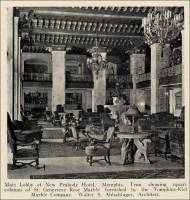
- Memphis, Tennessee -
the Peabody Hotel Lobby (Alabama Marble Co. advertisement
from Throvgh
The Ages Magazine,
April 1927, Vol. 4, No. 12, pp. 55.)
Alabama Marble Company, Main Office and Plant: Gantt’s Quarry, Alabama
Sales Department: 1701 Avenue A, Birmingham, Alabama
Producers of all grades of Alabama Marble, Manufacturers and Contractors for interior marble work in any kind of marble. Inquiries for prices and estimates should be addressed to the Sales Department, Birmingham, Alabama.
Interior marble work finished and set in place by Alabama Marble Company, Gantt’s Quarry, Alabama. Marble base, Belgian Black; wall marble above, Rose St. Genevieve; curb of fountain, Black and Gold. Fountain is Roman Travertine, made of one block specially quarried and imported for this purpose.
Alabama Cream A. A recognized standard among Interior White marbles. Unsurpassed for decorative and utilitarian purposes. Fine-grained, with Creamy-White background and moderate clouding. Impervious, non-staining, weather-proof and durable. Carves perfectly; takes and holds any polish from dull gloss to brilliant luster. The Alabama Marble Company has supplied millions of dollars’ worth of Alabama marble in hundreds of buildings without causing a single day’s delay on any one of them.
- Memphis, Tennessee -
the Peabody Hotel Lobby (Alabama Marble Co. advertisement
from Throvgh
The Ages Magazine,
April 1927, Vol. 4, No. 12, pp. 55.)
- Memphis, Tennessee - the Post Office (from “Notes on The Building Stones, Clays and Sands of Iron, St. Francois and Madison Counties, ” by G. E. Ladd, Assistant Geologist, in Bulletin 1, Geological Survey of Missouri, Jefferson City, April 1890.)
Granite quarried from Ozark Mountain granite quarry located a quarter of a mile south of Graniteville, Iron County, Missouri, was used in the construction of the Memphis Post Office building. “The stone taken out was, however, inferior to what can be obtained, as it was mostly surface rock.”
- Memphis, Tennessee - the United States Government Hospital (from “New Missouri Marble Mill,”in Stone Magazine, November 1925, Vol. XLVI, No. 11, pp. 674-676)
Colonial Grey Marble quarried by F. W. Steadley & Co., Inc., of Carthage, Missouri, was used in the construction of the United States Government Hospital building prior to 1926.
- Chattanooga, Tennessee - the Court House Building (from Missouri Marble,
by Norman S. Hinchey, Report of Investigations No. 3, Missouri Geological
Survey and Water Resources, Rolla, Missouri, 1946. Used with permission
of the Missouri Department of Natural Resources.)
- Finished Products from Missouri Stone in Texas
- Austin, Texas - the Court House (from Missouri Marble,
by Norman S. Hinchey, Report of Investigations No. 3, Missouri Geological
Survey and Water Resources, Rolla, Missouri, 1946. Used with permission
of the Missouri Department of Natural Resources.)
Ste. Genevieve Rose Marble, quarried in Ste. Genevieve County, Missouri, was used in the construction of the Court House building.
- Beaumont, Texas – a Church (from The Quarrying Industry of Missouri, by Ernest Robertson Buckley and H. A. Buehler, 1904, pages 133-134.)
Limestone quarried from the Carthage, Missouri, area was used with wholly or in part in the construction of the church. The color of the Carthage limestone ranges from brown and gray to white. Some of the stone has a faint blue tint.
- Clarksville, Texas – the First National Bank (from The Quarrying Industry of Missouri, by Ernest Robertson Buckley and H. A. Buehler, 1904, pages 133-134.)
Limestone quarried from the Carthage, Missouri, area was used with wholly or in part in the construction of the building. The color of the Carthage limestone ranges from brown and gray to white. Some of the stone has a faint blue tint.
- Corpus Christi, Texas - the Corpus Christi Cathedral. This information is presented on the Handbook of Texas Online web site.
White Alabama marble was used for the communion rail of hand-wrought iron and marble that separates the nave from the sanctuary. Other stones used in the Cathedral include the two statues of Italian Carrara marble, the walls of gray Carthage veinless marble from Carthage, Missouri, and a “four-foot-high wainscot of cream-colored Tavernelle Clair marble, capped and based with verde antique marble from Maryland.” Terrazzo of a cream-color was used with a border of Spanish tile on the floor.
- Dallas, Texas - the Airport Terminal Building (from Missouri Marble, by Norman S. Hinchey, Report of Investigations No. 3, Missouri Geological Survey and Water Resources, Rolla, Missouri, 1946. Used with permission of the Missouri Department of Natural Resources.)
Indorado or Inkley Vein Marble quarried from the Inkley Marble Quarries Company quarry located southwest of Ste. Genevieve, Missouri, was used in the construction of the airport terminal building.
- Dallas, Texas - the Magnolia Petroleum Building (Bradbury
Marble Co. Advertisement from Throvgh
The Ages Magazine, July 1923, Vol. 1, No. 3, pp. 55.)
The Bradbury Marble Company - St. Louis, Missouri - Edwardsville, Illinois
- Dallas, Texas - the Oriental Hotel (from “Notes on The Building Stones, Clays and Sands of Iron, St. Francois and Madison Counties,” by G. E. Ladd, Assistant Geologist, in Bulletin 1, Geological Survey of Missouri, Jefferson City, April 1890.)
Granite quarried from one of the quarries at Graniteville, Iron County, Missouri, operated by the Syenite Granite Company, was used in the construction of the Oriental Hotel. “The color of this stone is red or dark pink, mottled with gray and black, the red shades being due to feldspar, the others to a more or less smoky quartz. The rock takes a high, lustrous and handsome polish....” (According to this article, the Oriental Hotel was under construction circa 1890.)
- Dallas, Texas – the Oriental Hotel (from The Quarrying Industry of Missouri, by Ernest Robertson Buckley and H. A. Buehler, 1904, page 74)
Deep red colored granite quarried in the Graniteville, Missouri, quarries was used with wholly or in part in the construction of the Oriental Hotel.
- Dallas, Texas - the Southwestern Bell Telephone Co. Building - the Corridors & Lavatories (from Missouri Marble,
by Norman S. Hinchey, Report of Investigations No. 3, Missouri Geological
Survey and Water Resources, Rolla, Missouri, 1946. Used with permission
of the Missouri Department of Natural Resources.)
Ozark Veined Marble (a limestone) quarried at Carthage, Missouri, was used in the construction of the corridors and lavatories in the interior of the Southwestern Bell Telephone Co. building.
- Dallas, Texas – St. Paul’s Sanitarium (from The Quarrying Industry of Missouri, by Ernest Robertson Buckley and H. A. Buehler, 1904, pages 133-134.)
Limestone quarried from the Carthage, Missouri, area was used with wholly or in part in the construction of the sanitarium. The color of the Carthage limestone ranges from brown and gray to white. Some of the stone has a faint blue tint.
- Fort Worth, Texas - the U.S. Post Office or Court
House Buildings (from Missouri Marble,
by Norman S. Hinchey, Report of Investigations No. 3, Missouri Geological
Survey and Water Resources, Rolla, Missouri, 1946. Used with permission
of the Missouri Department of Natural Resources.)
Marble quarried from the Phenix Marble Company’s “Old West Quarry” at Phenix, Greene County, Missouri, was used in the construction of the U.S. Post Office or Court House buildings prior to 1942.
- Houston, Texas - the County Hospital Building (from Missouri Marble,
by Norman S. Hinchey, Report of Investigations No. 3, Missouri Geological
Survey and Water Resources, Rolla, Missouri, 1946. Used with permission
of the Missouri Department of Natural Resources.)
Ozark Veined Marble (a limestone) quarried at Carthage, Missouri, was used in the construction in the interior of the County Hospital building.
- Houston, Texas -
the State National Bank (Salomone-O'Brien Marble Co. advertisement
from Throvgh
The Ages Magazine,
April 1925, Vol. 2, No. 12, pp. 68.)
Salomone-O’Brien Marble Co. Knoxville, Tennessee
- Paris, Texas - the Depot (from the “Notes From Quarry and Shop” section in Stone:
An Illustrated Magazine, Vol. XI, No. 6, November, 1895, Frank W. Hoyt, Publisher, New York, pp. 572.)
Notes From Quarry and Shop: “They sawed stone for the new public library at Kansas City, Mo., will be furnished by Carthage Stone Co., Carthage, Mo. Will take nearly 100 carloads. The stone for new courthouse, Paris, Tex., 140 cars, is also being gotten out at Carthage. Also for depots at Parsons, Kan., and Sedalia, Mo.”
- San Antonio, Texas - the U. S. Post Office Building (from Missouri Marble,
by Norman S. Hinchey, Report of Investigations No. 3, Missouri Geological
Survey and Water Resources, Rolla, Missouri, 1946. Used with permission
of the Missouri Department of Natural Resources.)
Ozark Tavernelle Marble (a limestone) quarried at Carthage, Missouri, was used in the construction of the interior of the U. S. Post Office building.
- Austin, Texas - the Court House (from Missouri Marble,
by Norman S. Hinchey, Report of Investigations No. 3, Missouri Geological
Survey and Water Resources, Rolla, Missouri, 1946. Used with permission
of the Missouri Department of Natural Resources.)
- Finished Products from Missouri Stone in Utah
- Salt Lake City, Utah - the Elks Club Building (from “New Missouri Marble Mill,”in Stone Magazine, November 1925, Vol. XLVI, No. 11, pp. 674-676)
Colonial Grey Marble quarried by F. W. Steadley & Co., Inc., of Carthage, Missouri, was used in the construction of the Elks Club building prior to 1926.
- Salt Lake City, Utah - the Masonic Temple (from article entitled, “Salt Lake City, Utah: The Use of Marble In the State Capitol and Other Buildings,” in Throvgh The Ages Magazine, March 1927, Vol. 4, No. 11, pp. 23-30.)
“...Scott and Welch, architects, not long since completed their designs for the new $1,000,000 Masonic Temple, which is now well under way. It is being erected on beautiful South Temple Street, in the midst of palatial residences....”
- Salt Lake City, Utah - the Elks Club Building (from “New Missouri Marble Mill,”in Stone Magazine, November 1925, Vol. XLVI, No. 11, pp. 674-676)
- Finished Products from Missouri Stone in Vermont
- Montpelier, Vermont - the High School (from Missouri Marble, by Norman S. Hinchey, Report of Investigations No. 3, Missouri Geological Survey and Water Resources, Rolla, Missouri, 1946. Used with permission of the Missouri Department of Natural Resources.)
Eldorado or Ste. Genevieve Istrian Marble quarried from the Inkley Marble Quarries Company quarry located southwest of Ste. Genevieve, Missouri, was used in the construction of the High School in Montpelier.
- Montpelier, Vermont - the High School (from Missouri Marble, by Norman S. Hinchey, Report of Investigations No. 3, Missouri Geological Survey and Water Resources, Rolla, Missouri, 1946. Used with permission of the Missouri Department of Natural Resources.)
“Napoleon Gray marble was used throughout in the Coshocton National Bank, Coshocton, Pennsylvania. Designed and executed by the Taylor-Palmer Company, Milwaukee.” (pp. 43) 
“St. Philomena Roman Catholic Church, Lansdowne, Pa., has a wainscot of Napoleon Gray marble. George I. Lovett, Philadelphia, Architect; Marble Contractor, John Hegarty, Philadelphia.” (pp. 27) 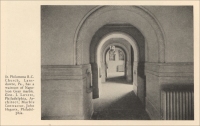
“The Tenth National Bank of Philadelphia. The floors and counters are of Napoleon Gray. Paul A. Davis, 3d., Philadelphia, Architect; Marble Contractor, William A. Wafer, Philadelphia.” (pp. 44) 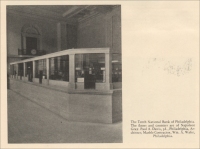
Commercial use of material within this site is strictly prohibited. It is not to be captured, reworked, and placed inside another web site ©. All rights reserved. Peggy B. and George (Pat) Perazzo.
-
